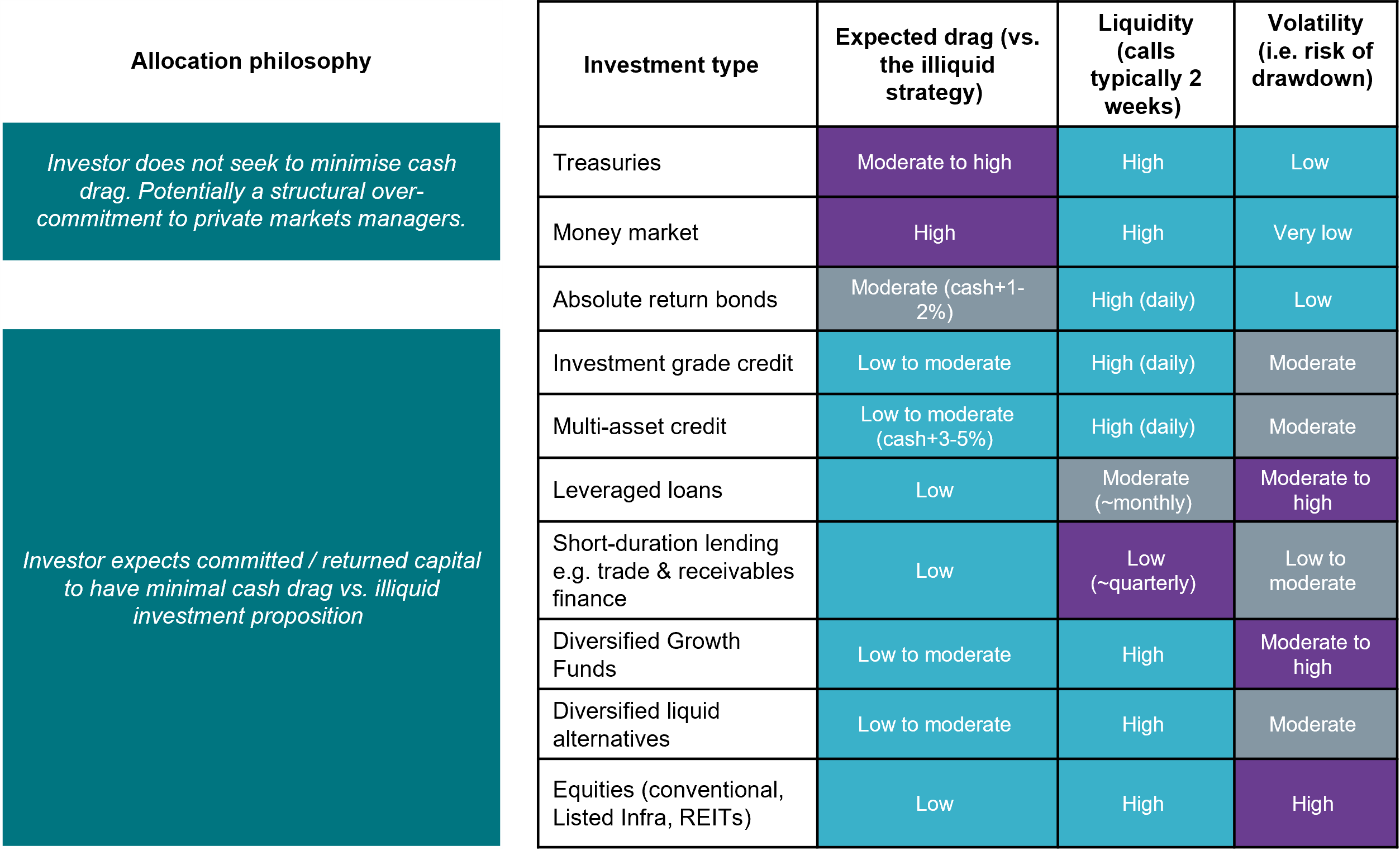bfinance insight from:

Mathias Neidert
Managing Director, Head of Public Markets

Trevor Castledine
Senior Director, Private Markets
As investor allocations to illiquid strategies have boomed, the question of what to do with the capital that is committed to and returned from those strategies has become increasingly complex.
This challenge is particularly evident in the case of private credit strategies, due to the cashflow implications of their shorter time horizons and income-generative characteristics. Unlike private equity, private credit lacks an acceptable ‘public market equivalent’ proxy — an investible liquid strategy that should deliver relatively similar risk/return characteristics (if we ignore the purely optical reduction in volatility) but without the illiquidity premium.
A wide variety of liquid investment strategies are now presenting themselves as effective partners to investors that have complex illiquid portfolios to manage. Over the past decade, we’ve seen many pension funds and other investors using Diversified Growth Funds (DGF), Multi Asset Credit (MAC) and more conservative Absolute Return Bond strategies for the purpose. We have also noted cases of investors using liquid real asset strategies (e.g. REITs and Listed Infrastructure) to handle commitments to and run-off from illiquid portfolios, as well as various other strategy types (see table below).

This type of usage does not tend to form a formal leg of marketing toolkits: firms do not vigorously promote their strategies as buffer pools from which money will be removed whenever convenient (unless, that is, they own both strategies). In practice, however, many managers are happy to play this role, as evidenced by high level of RFP responses when running manager selection exercises with this remit.
Yet these ‘partner strategy’ approaches can create challenges, with tensions becoming most evident during periods of disappointing returns or market dislocation. Where an investor explicitly seeks to minimise cash drag, frustrations can surface when returns fail to meet the desired level – hence the declining appeal of DGFs relative to MAC in recent years. In addition, periods of disruption can lead to drawdown or a reduction in liquidity of the ‘liquid’ strategy, making it relatively challenging to use those assets for capital calls at two weeks’ notice.
Where an investor explicitly seeks to minimise cash drag, frustrations can surface
Indeed, such drawdowns often occur at precisely the times when the climate becomes most attractive for deployment into private markets. This tension may be especially apparent in the case of ‘credit opportunities’ or ‘distressed credit’ strategies. Exiting when those capital calls come in can result in substantial realised losses – even where illiquid investment managers try to make those calls as predictable and well-communicated as possible using subscription facilities. The only alternative to those losses may be breaching capital calls, borrowing money (either directly or using the manager’s bridge financing facility, both of which entail a cost) or taking money from other liquid strategies such as Treasuries – which may be among the few strategies that are performing well in a troubled market environment.
Private markets managers seek a slice of the action
We have seen a recent trend among private credit managers towards establishing their own liquid strategies, designed to sit alongside their illiquid funds. These innovations have partly been driven by the changing commercial dynamics of private credit fund management, with firms now largely unable to charge fees on committed (non-invested) capital. Such vehicles tend to be comprised of Leveraged Loans and an assortment of other credit types: as such, there are constraints to their liquidity and they may well have a riskier profile than the private debt strategy for which the capital is intended. Similarly, we see examples of Infrastructure managers with both ‘listed infrastructure’ and conventional infrastructure vehicles, packaging solutions for clients that promise a cashflow management solution (and, potentially, some tactical positioning).
Such vehicles can certainly limit the potential drag on returns and reduce the administrative burden of managing cashflows. Yet they also reduce investor control: the manager, not the investor, is often responsible for determining when the investor’s capital leaves the more ‘liquid’ investment and enters the ‘illiquid’ strategy. In addition, for an investor with a well-diversified portfolio, small holding pens at multiple asset managers may well not represent the most efficient way of using capital. Furthermore, such managers will not typically have been selected for their capabilities in liquid asset classes.
On a related note, we are seeing an increasing number of private market investment managers producing ‘evergreen’ fund solutions, where the GP manages reinvestment of the returning capital in return for more ‘permanent capital’. Recent manager searches have identified a substantial and growing universe of offerings of this type.
Considering the options
It is worth stepping back to view the wide range of liquid (or relatively liquid) investment strategies that investors may be using to hold committed or non-committed capital to support an illiquid investment programme. The table above shows a (condensed) list of investment strategies which may be used in this manner.
Treasuries do not necessarily deliver low volatility, especially higher up the yield curve – which is where an investor needs to be if seeking to reduce cash drag. The highest cash drag is produced by money market exposure, where the rate is currently negative for European investors and negligible for those in other regions. The bulk of these strategies have daily liquidity (including many MAC and AR bond funds). Leveraged loans represent the closest proxy to private debt but tend to have less-than-monthly liquidity and drawdown risk is significant; the same arguments can be made about trade finance and other short-duration lending strategies.
The choice of strategy will, first and foremost, be determined by the investor’s allocation approach. Depending on how the portfolio is structured, how asset allocation is managed and how willing the investor is to use leverage, the investor may or may not need to ensure that the liquid investments from which commitments are funded should have minimal cash drag versus the illiquid investments for which the capital is intended. There are a wide variety of approaches, including intentional over-allocation and/or over-commitment to private markets versus the desired level of allocation (based on an expected pace of drawdowns and distributions).
The approach will also fundamentally be shaped by how cashflow-positive the relevant investor happens to be, since those benefiting from stronger cashflows are able to tolerate a little more uncertainty in the model – such as the risk of becoming over-invested or the risk that it will not be possible/appropriate to exit the intended strategies at the time of the call.
Absolute return bond strategies – more conservative than their MAC cousins – are particularly interesting in this matrix, especially for investors handling private credit portfolios. While they do not claim the ability to limit cash drag to the same extent as the riskier credit or loan strategies (generally targeting cash plus one or two percentage points), they provide more resilience against market downturns and a surer liquidity profile (typically daily).
Developing a robust approach
As private markets become an increasingly large and diverse portion of investors’ portfolios, it is important that the strategy adopted for handling allocated, committed and returned capital is robust and well-managed in order to reduce the substantial potential inefficiencies and not-inconsiderable risks. It is also important that this strategy can evolve over time: an investor with a more mature and stable private markets portfolio, for example, may find that capital returns have a greater propensity to match up with capital calls, although they are of course unlikely to mirror each other precisely.
Various types of liquid strategy can be used to complement and fund illiquid strategies. In defining an approach, investors must carefully consider the trade-offs around return, liquidity and volatility. Investors that seek an explicit partnership with an asset manager for this purpose can benefit from a surprisingly large universe of providers that are keen to shape their products and services to meet this growing demand.
Important Notices
This commentary is for institutional investors classified as Professional Clients as per FCA handbook rules COBS 3.5R. It does not constitute investment research, a financial promotion or a recommendation of any instrument, strategy or provider. The accuracy of information obtained from third parties has not been independently verified. Opinions not guarantees: the findings and opinions expressed herein are the intellectual property of bfinance and are subject to change; they are not intended to convey any guarantees as to the future performance of the investment products, asset classes, or capital markets discussed. The value of investments can go down as well as up.


 English (Global)
English (Global)  Deutsch (DACH)
Deutsch (DACH)  Italiano (Italia)
Italiano (Italia)  Dutch (Nederlands)
Dutch (Nederlands)  English (United States)
English (United States)  English (Canada)
English (Canada)  French (Canada)
French (Canada) 

